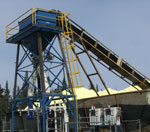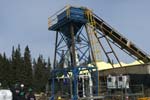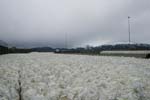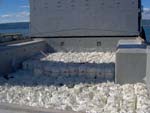
Case Study: Recycling Sulfur Material
Kenai refinery overcomes handling logistics to move 36,000 tons
- By Keith Simpson
- Jul 09, 2009
 |
| See Caption #1 |
Managers at a petroleum refinery in Kenai, Alaska, wanted to recycle over 36,000 tons of sulfur but a depressed sulfur market ($100 a ton) made the recovery effort unfeasible. When the price increased to $500 a ton at the end of 2007, the refinery contacted AIMM Technologies, Inc., a Texas-based petroleum service company.
"Alaska is a logistical nightmare to recycle petroleum byproducts such as sulfur," noted Brooks Bradford, president of AIMM Technologies. "It requires a lot of handling, and you have to be careful because sulfur is a hazardous material that can catch on fire rather easily.
 |
| See Caption #2 |
"When we got the go-ahead to bag and recover the sulfur, AIMM Technologies felt that the best way to process the diesel fuel byproduct was to use bulk bag fillers."
The refinery stipulated that the facility had to be mobile and easy to dismantle for use at another sulfur recovery site once recovery at the Kenai site was complete.
"After researching various suppliers, AIMM selected Spiroflow Systems, which could meet the tight delivery schedule of four weeks with start-up and installation in an additional two weeks.
Spiroflow Systems recommended two of its 'Spirofil' Model "C1-2" Weight Fillers, which are specially designed for pallet handled flexible intermediate bulk containers (FIBCs). This model is ideal for uses in which flexible or rigid FIBCs are filled and removed by lift truck and can handle bags with a capacity between 2,000 and 4,000 pounds.
 |
| See Caption #3 |
The two bulk bag fillers were customized before dispatch from the Spiroflow Systems plant in Monroe, N.C. The plastic-coated bags, a standard option on the fillers, use conductive threads to specifically overcome the hazardous characteristics of sulfur and the power supply had to be changed to a Class 1 Division 2, because an electric spark could ignite the sulfur.
Spiroflow sent the bulk bag fillers and a technician within a five-day delivery time to the site. The company's technician removed the standard stainless steel filling nozzle and filling spout to accommodate the chutes from the open hopper and the free-flowing sulfur material.
"We appreciated the extra effort by Spiroflow since we were not familiar with bulk bag fillers," Bradford noted. "We needed training, too."
The System
The Bulk Bag Filler facility included:
- A 28-foot frame to support the system,
- A hopper on top of the frame into which the sulfur from the sulfur stockyard was loaded (AIMM Technologies designed these first elements),
- The two modified Bulk Bag Fillers, and
- Two roller accumulating conveyors on a National Type Evaluation Program (Weights and Measures Trade Standards)] -approved weight platform.
A bucket loader brought the sulfur to a conveyor belt from the storage pile on the refinery site. The belt
 |
| See Caption #4 |
was positioned in a 30-foot incline above the top of the hopper. Because sulfur has extraordinary binding properties and weighs 125-lbs/ft
3, it had to be funneled, not poured, into the hopper. A series of diverter vales and slide gate valves controlled sulfur movement through the system to the bulk bag fillers.
The base of each bag was mounted on the cell weight platform, which is standard for the bulk bag fillers. The platform's roller conveyor system allows the lift truck to easily remove the FIBCs. The integral controller opened and closed the gate valves according to bag weight. Once a bag was close to reaching its target weight, the controller sent a signal to the gate valve, allowing only a trickle of sulfur into the bag until it reached its 3,300 lb capacity.
The FIBCs had straps that latched onto the frame on all four corners and onto the two chutes. Stevedore straps were placed over the bags for easy pick-up. A quick release latchable hook released the straps when signaled by the controller to do so. A lift truck then picked them up by the straps and moved them to their appropriate destination.
36,000 Tons of Recyclable Material
According to Jeff Deese, vice president of the Alaska Division for AIMM Technologies , the facility was in operation from the end of March to mid-July in 2008. The Kenai facility had 10 people working each 8-hour shift, four of which were at the bagging station. The facility averaged 300 bags a shift. In all, 36,000 tons of sulfur was recovered in 27,000 FIBC bags.
Ultimately, most of the bags were transported to the Port of Homer, Alaska, about three hours from Kenai. The sulfur was sold to a third party who shipped it to an inland river port in China where it will be used mainly as fertilizer.
The facility was recently dismantled and is in the process of being reassembled at another sulfur recovery site in Canada where it was converted to handle 4,000 lb bags instead of the 3,300 lb bags handled at the Kenai facility, an increase in capacity of 17.5 percent.
|
Caption #1: The Bulk Bag Filler facility of AIMM Technologies at the Kenai petroleum refinery included a 28 foot high frame to support the system, a hopper on top of the frame into which the sulfur from the sulfur stock yard was loaded, two modified Model "C1-2" Bulk Bag Fillers from Spiroflow Systems and two roller accumulating conveyors on a NTEP-approved weight platform. When full, the 3300 lb (1.5 metric ton) capacity bags were rolled off the conveyor to a 5-foot long gravity bed conveyor. From here, lift trucks picked up the bags of sulfur for delivery to storage or directly onto trucks for transport. The bags were plastic coated and complete with conductive threads to specifically overcome the hazardous characteristics of sulfur.
Caption #2: The 3,300 lb bags were filled to capacity and then taken by lift trucks directly to one of four trucks or to the on-site storage facility. In all, 36,000 tons of sulfur was recovered in 27,000 FIBC bags.
Caption #3 :Overall view of some of the 27,000 FIBC bags of recovered sulfur.
Caption # 4: At the Port of Homer, Alaska, the 27,000 lb FIBC bags filled with sulfur from the diesel fuel at the Kenai facility were offloaded to an ocean vessel for transport to China where it will be used as fertilizer.
|
About the Author
Keith Simpson is marketing manager for both Spiroflow Ltd. in the United Kingdom and Spiroflow Systems in the United States. He was trained as an engineer with qualifications from UK Polytechnic (now a university) and has been involved in the handling, storage, and processing dry bulk solids for more than 38 years.